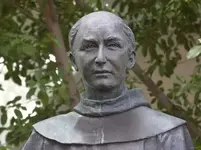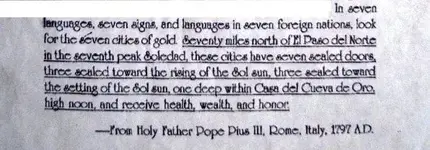cactusjumper
Gold Member
I have mentioned elsewhere that I suspect Fr. Carlos de Rojas (of Arizpe) of being a major player in matters related to mining or Jesuit treasure in general.
Enter exhibit A:
View attachment 972096
which is the facade of St. Francis Xavier Parish in Phoenix, AZ.
The three figures are: On top, Ignatius Loyola. To his right, Eusebio Kino, and to his left, Fr. Carlos de Rojas (your right, when looking at the picture).
The fact that the statue is Fr. Rojas is confirmed by a few sources, one of who is a poster, Joey W. who related elsewhere that:
This was furthermore confirmed by Jim Hatt, who had his own, separate, source.
Now, imagine my surprise when I found out that the St. Francis Xavier Parish is now denying that it is Fr. Rojas, and this is confirmed by their church brochure. They are now claiming that the statue on your right, in the picture above, is of the Franciscan monk, Junipero Serra, even though it looks absolutely nothing like the real Serra. Please find below, exhibit B and C, two different statues of the real Serra who you will notice bears no resemblance to what is on the facade:
View attachment 972098View attachment 972099
Note on both authentic Serra statues, the Franciscan habit with its typical simple white rope going down the right side of the statues, as well as the oversized cowl.
This is not so on the statue on your right on the facade in the first picture. That statue is also wearing Jesuit beads that are exactly identical to the beads that Kino has in his right hand, on the other side of the facade.
Now why should the Parish lie so blatantly about something like this?
What did Rojas do to incur such drastic behavior?
Also, one another thing- the Parish is claiming that the bell below the statue is the "El Camino Real mission bell," (per the brochure). As if Serra has anything to do with a bell, never mind one with sprues still attached.
Furthermore, "El Camino Real" as we know it, isn't a mission, but the King's highway, connecting 21 missions in Alta California. None of them are named "El Camino Real."
On the other hand, we do know the story of Rojas and the silver bell.
deducer,
Good to see you providing such reliable sources as, Jim Hatt and Joey W. Did they happen to tell you when the Jesuits changed Father Rojas for Father Serra?

Thank you,
Joe Ribaudo






